 alt="Puer Surrounding Counties and Towns: Weekly & Special Local Markets Travel Guide"
/>
alt="Puer Surrounding Counties and Towns: Weekly & Special Local Markets Travel Guide"
/>
The Most Famous Puer Tea Mountains in Yunnan
The geographical distribution of ancient Pu’er tea trees
Pu’er tea is a kind of tea only available in a specific geographical area. Pu’er tea is defined as a kind of tea with unique quality characteristics, which is made of Yunnan large leaf sun-dry green tea (云南大叶种晒青绿茶)with special processing technology within the scope of geographical indication protection according to the latest national standard in 2008 “geographical indication product Pu’er tea《地理标志产品普洱茶》” (GB / T 22111-2008),
This means that to be called Pu’er tea, in additional to being made according to the specific processing technology of Pu’er tea, there also have two conditions must be met: raw materials and processing must be within the scope of geographical indication protection. The protection scope of geographical indication products of Pu’er tea is 639 townships of 11 prefectures and cities in Yunnan Province, including Xishuangbanna(西双版纳), Pu’er(普洱), Lincang(临沧) and Baoshan(保山). These four tea areas are located in the western and southern border areas of Yunnan Province, distributed on both sides of the Lancang River(澜沧江), bordering Myanmar, Laos and other countries
Four production areas of Pu’er tea
It is in this mysterious area inhabited by ethnic minorities that it is proved to be the birthplace of tea. It can be said that the drinks called “tea” in the world are all from Yunnan(云南). In the Ming and Qing Dynasties, Pu’er tea came into being and went to a brilliant era. Large-scale and organized cultivation of tea trees was also a historical feat accomplished in these two dynasties.
Today, in the alpine forest land with an altitude of more than 1000 meters in Lancang River (澜沧江)Basin, the ancient tea garden that has experienced historical vicissitudes and natural disasters is still lush, or distributed in patches, or scattered in a single plant. There are more than 270000 acre of wild tea community and ancient tea garden in Yunnan.
★ Tea area distribution in Xishuangbanna(西双版纳)
Xishuangbanna(西双版纳)which means “twelve thousand acre” (twelve, in Dai Language, it means “Xishuang”(西双) and “Banna”(版纳)which means “one thousand acre”, that’s an administrative unit collecting taxes and labor). The whole Xishuangbanna(西双版纳) has 82000 acre of ancient tea garden, which is distributed in 19 towns and more than 100 villages in two counties and one city.
Banna tea area(版纳茶区) is one of the area with the longest production history and the highest output of Pu’er tea. It has jurisdiction over 2 counties and 1 city, namely Menghai County(勐海县), Mengla County(勐腊县) and Jinghong City(景洪市). The famous “Menghai tea factory” (勐海茶厂)was born in Menghai(勐海), while the “six famous tea mountains” in the Qing Dynasty were mainly distributed in Mengla County(勐海县) (only Youle tea mountain(攸乐茶山) is located in Jinghong City(景洪市)).
Distribution of ancient tea mountains in Xishuangbanna(西双版纳) (6 to the East and 8 to the west of Lancang River(澜沧江))
Of the fourteen ancient tea mountains,seven in Menghai counties(勐海县) to the west of Lancang River(澜沧江), FIve in Mengla counties(勐腊县) to the East, one in west of river and one in east of river in Jinghong City(景洪市). The age of ancient tea trees varies from 100 years to 1700 years, but most of them are between 200-500 years.
Ancient six tea mountains:
The six ancient tea mountains in Banna(版纳) are the important production areas of Pu’er tea in Qing Dynasty, and also the window for the mainland to understand Pu’er tea at that time. There are some differences in the historical records of the six major tea mountains, including Yiwu (MANSA)(易武,曼洒), Yibang(倚邦), manzhuan(蛮砖), gedeng(革登), mangzhi(莽枝) and Youle(攸乐). The area about more than 2000 square kilometers, it is distributed in the east of Xishuangbanna(西双版纳) and on the East Bank of Lancang River(澜沧江).
1. Tea mountain of Yiwu Mansa (易武、曼洒)
The meaning of the names in local language means the place where the beautiful villain lives.
The tea mountain include Yiwu (易武)mountain, Mansa(曼洒) tea mountain and Manla(勐腊) tea mountain etc. Yiwu(易武) mountain is located in the north of Mengla County(勐腊县), 110km away from Mengla(勐腊) and Mansa(曼洒) in the north of Yiwu, it also belong to Yiwu(易武) tea area. The annual average temperature is 17.2 degrees, and the annual average precipitation is 1500-1900 mm. It makes Yiwu tea soup is soft and smooth, the taste is clear and sweet, the bitter and astringent feeling is weak, and the back sweet is better.
The distribution of the ancient tea tree: Yiwu(易武), Mansa(曼洒), Mahei(麻黑), Luoshuidong(落水洞), Guafengzhai刮风寨), laodingjiazhai(老丁家寨), Manxiu(曼秀), Daqishu(大漆树) etc.
2.Tea mountain of Yibang (倚邦)
The meaning of the names in local language means that the place where have tea trees and well.
Yibang(倚邦) is located in the northernmost part of Mengla County(勐腊县), under the jurisdiction of Xiangming township(象明乡). It covers 19 natural villages with an area of 360 square kilometers and a large altitude span. It is distributed from 600 meters to 1900 meters. The altitude of Mansong(曼松) tea mountain is 1340 meters. Yibang (倚邦)ancient tree tea, due to its small and medium-sized leaf species, it has a light bitter taste, a little more astringency than bitterness, a faster return to sweetness, a unique fragrance and a little honey flavor. Among them, Mansong(曼松) tea is bitter and astringent, the tea soup is sweet, smooth and full, and the tea fragment stay long in the bottom of the cup.
The distribution of the ancient tea tree: Yibang(倚邦)、Mansong(曼松)、Xikong(嶍崆)、Jiabu(架布)、Mangong(曼拱)、Malishu(麻栗树) etc.
3.Tea Mountain of Manzhuang (蛮专,亦称 “曼庄”)
The meaning of the names in local language means great stockaded village.
Manzhuang (曼庄)is located in the south and east of Xiangming Township(象明乡), Mengla County(勐腊县) and bordering Yiwu(易武) tea area,the area about 300 square kilometers, the altitude about 1100m. The tea soup here is full, thick and smooth, with strong mountain flavor, long-lasting fragrance at the bottom of the cup, fast and long-lasting sweetness, light bitterness and deep throat rhyme.
The distribution of the ancient tea tree: Manzhuang(曼庄)、Manlin(曼林)、Manqian(曼迁)、Bazongzhai(八总寨)etc.
4.Tea mountain of Gedeng(革登)
The meaning of the names in local language means high ground.
Gedeng(革登) is located in Anle village(安乐村), Xiangming Township(象明乡), Mengla County(勐腊县), between mangzhi(莽枝) and Yibang(倚邦) tea area. The altitude about 1300 meters. The tea here mountain rhyme is obvious, the bitterness is weak, the back sweet is better, the soup quality is smooth.
The distribution of the ancient tea tree: Zhibang(植蚌)、Xinfa(新发).
5.Tea mountain of Mangzhi(莽枝)
The meaning of the names in local language means Buried copper land.
Mangzhi(莽枝) is located in the southwest of gedeng(革登) tea mountain. It belongs to Anle village(安乐村), Xiangming Township(象明乡), Mengla County(勐腊镇), with an altitude about 1400m. The tea here is similar with Gedeng(革登) tea, which is a little less fragrant. The bitterness and astringency are weaker, and the back sweet is faster, and long-lasting fragment bottom of the cup is better.
The distribution of the ancient tea tree: Yanglin(秧林)、Hongtupo(红土坡)、Manya(曼丫)、Jiangxi bay(江西湾)、Kouduo(口夺) etc.
6.Tea mountain of Youle(攸乐)
The mountain name meanings is the residence of Jino(基诺) nationality, they called Youle nationality in past.
Jinuo township(基诺乡) is located in Jinghong City(景洪市), which is 75km long in the west of Jinuo mountain(基诺山) and 50km wide in the South and North. It is the largest existing ancient tree tea area among the six ancient tea mountains, with an altitude 575m to 1691m, average temperature is 18-20 degrees, and an annual precipitation is 1400mm.
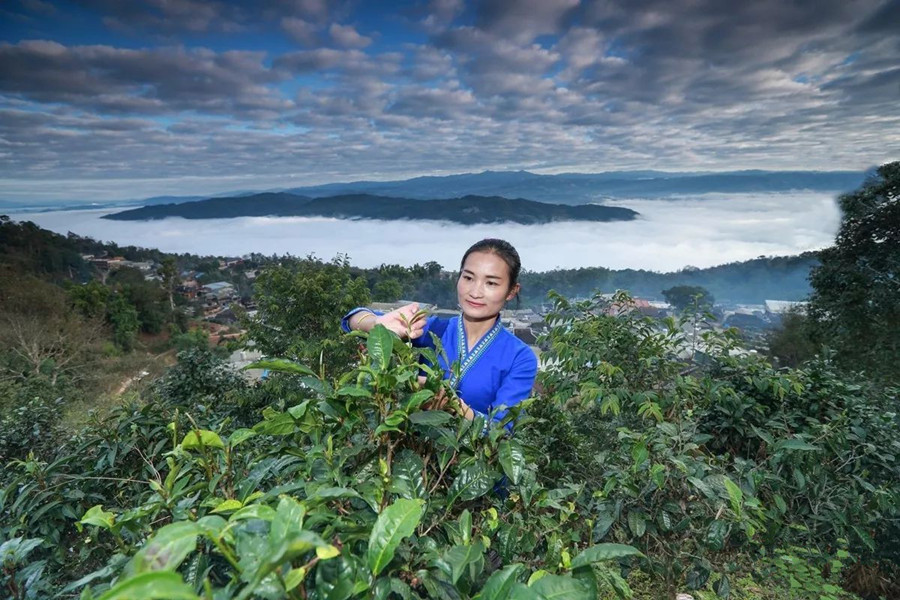
The distribution of the ancient tea tree: Longpa(龙帕)、Situ old walled(司土老寨)、Mezhuo(么卓)、Bapiao(巴飘) etc.
Eight tea mountain of newcomer: They located in the west of Lancang River(澜沧江). From north to south are: mannuo(曼糯), Menghai Mengsong(勐海勐宋), nannuoshan(南糯山), Pasha(帕沙), Hekai(贺开), Bulang mountain(布朗山), Jinghong Mengsong(景洪勐宋); Bada(巴达) is in the West.
1.Tea mountain of Mannuo(曼糯)
Mannuo is located at the northernmost end of Menghai County(勐海县), belonging to Mengwang village(勐往村), mengwang township(勐往乡), which borders Lancang(澜沧) and Simao (思茅)district of Pu’er(普洱). This is the first station of Lancang River(澜沧江) from Pu’er(普洱) City to Xishuangbanna(西双版纳). The altitude is 1200-1300 m and the annual precipitation is 1300-1400mm. The tea in here tastes fresh, it has obvious bitterness and astringency, slow back sweetness and strong fragrance.
The distribution of the ancient tea tree: There are mainly three strongholds, Dazhai(大寨), Shangzhai(上寨) and Zhongzhai(中寨).
2.Tea mountain of Mengsong(Menghai) 勐宋(勐海)
The meaning of the names in local language means “The dam on the top of the mountain.”
It is located in Mengsong Township(勐宋乡), Menghai County(勐海县), bordering east of Jinghong City(景洪市) and south of granghe township(格朗和乡) , facing nannuo mountain(南糯山) and across Liusha river(流沙河). Naka tea area(那卡茶区) is one of the tea are in Mengsong(勐宋), the altitude is 1600 meters , Baotang tea area (保塘茶区) altitude is 1700-1800 meters .The annual precipitation is 1400mm. The tea in here is pure, bitter and astringent and slow in sweet return.
The distribution of the ancient tea tree:Daan(大安)、Nanben(南本)、Baotangxinzhai(保塘新寨)、Bameng(坝檬)、Damanlv(大曼吕)、Naka(Laka)那卡(腊卡).
3.The tea mountain of Nannuo mountain (南糯山)
It located in gelanghe Township(格朗和乡), Menghai County(勐海县), next to the highway of Jinghong (景洪)to Menghai(勐海) . 24 kilometers away from Menghai county(勐海县). The average altitude is 1400m and the annual precipitation is 1500-1750mm. The annual average temperature is 16-18 ℃. The tea soup here is full in quality, fast in returning to sweet and the wild flavor is obvious. Traditionally, the aroma of nannuoshan(南糯山) tea is full and bitter. But the bitterness is weak and the aroma is not obvious in recent years.
The distribution of the ancient tea tree: Zhulin village(竹林寨), Banpo village(半坡寨), girl village(姑娘寨), etc.
4. Tea mountain of Pasha(帕沙)
The meaning of the names in local language means A mountain and a river.
It located in Pasha village(帕沙村), southwest of gelanghe Township(格朗和乡), Menghai County(勐海县), between nannuo mountain(南糯山) and Bulang mountain(布朗山), the altitude is 1200-2000 meters, annual average temperature is 22 ℃ and the annual rainfall is 1500 mm. The tea here is obviously bitter and astringent, but it can be turned into clear and sweet with obvious shenjing .
The distribution of the ancient tea tree: Pasha new village(帕沙新寨)、Pasha old village(帕沙老寨)、Pasha medium village(帕沙中寨)、Nangan(南干)、Laoduan(老端) etc.
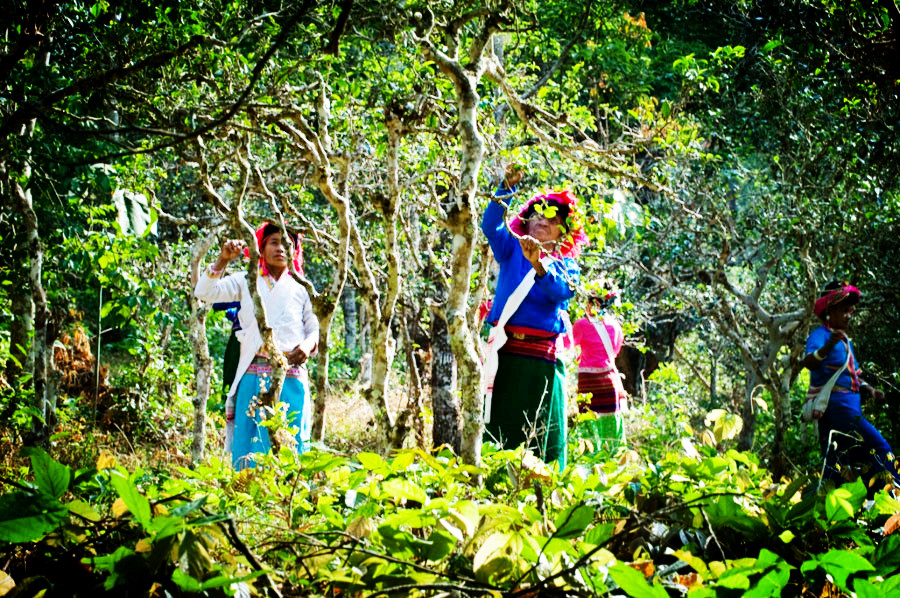
5. Tea mountain of Hekai(贺开)
The meaning of the names in local language means the first place to see the sun.
It is located in Hekai village(贺开村), Menghun Town(勐混镇), Menghai County(勐海县), north to the famous ancient tea mountain of Nannuo mountain (南糯山)tea area, east to Ladameng(拉达勐) reservoir and west to Menghun dam(蒙混坝子). Altitude is 1400-1700m. The tea soup here is full in quality, slightly bitter and astringent. The bitterness turns into sweetness quickly, and the wild tastes is obvious.
6.Tea mountain of Bulang mountain(布朗山)
It is located in Bulang Nationality Township(布朗族乡), Bulang mountain(布朗山), Menghai County(勐海县), bordering Myanmar in the south. The annual rainfall is 1300-1500 mm and the annual average temperature is 18.7 degrees. The altitude of old and new banzhang(班章) is 1600-1700 meters, while that of old man’e village(老曼娥寨) is relatively low, about 1200 meters. The old banzhang tea(老班章茶) here is plump in appearance, strong in taste, bitter and astringent obviously. It’s quick and lasting sweetness and has obvious tea flavor. The old man’e tea(老曼娥茶) is similar to the old banzhang tea(老班章茶), with more bitterness and slower into sweetness.
The distribution of the ancient tea tree: Old banzhang(老班章)、New banzhang(新班章)、Old Man’e(老曼娥)、Manxinyuan(曼新竜)、Mannuo(曼糯).
7.Tea mountain of Mengsong(Jinghong) 勐宋(景洪)
Located in Mengsong village(勐宋村), Da Menglong Town(大勐龙镇), Jinghong City(景洪市), at the southernmost end of Jinghong City(景洪市), it is also the ancient tea area with the lowest latitude in Yunnan Province with an altitude of 1500-1800 meters and moderate rainfall. The tea here has obvious wild tastes, full fragrance, thick soup, strong fragrance in cup, short bitterness of sweet tea, fast into sweet; bitter tea is obviously bitter, slow into sweet.
The distribution of the ancient tea tree: Mengsong great village(勐宋大寨)、Miaochu mountain(苗锄山)、Manqian old village(曼迁老寨)、Manjiapokan(曼家坡坎)、Manwoke(曼窝科)、Manjiaganbian(曼加干边)、Manjiajiao(曼加角)、Manmaiyao(曼卖窑)etc.
8. Tea mountain of Bada(巴达)
The meaning of the names in local language means footprints of immortals.
It is located in the west of Menghai County(勐海县), formerly belongs to Bada Township(巴达乡), now belongs to Xiding Township(西定乡), facing Myanmar from the west of Nanlan River (南览河). Altitude is 1580-2000 meters. Here the tea aroma is pure, bitter and astringent, sweet in the soup, sweet and clear.
The distribution of the ancient tea tree: Mangmai(曼迈)、Zhanglang(章朗)、manpale(曼帕勒).
Summary of Banna (版纳)tea area: The quality of tea is thick and soup is full, except for some small leaf species, the bitterness is obvious of tea in Banna(版纳) tea area. This is closely related to the climate and natural environment in the lower reaches of Lancang River(澜沧江). Banna(版纳) tea area has a relatively low temperature and strong light in Pu’er(普洱) tea area, which leads to a high content of tea polyphenols and catechins, a clear sense of bitterness, the hegemony of banzhang(班章) and man’e(曼娥), the bitterness of xiaomengsong(小勐宋) bitter tea have the direct association.
The age of ancient trees in Banna(版纳) tea area is more than 100-500 years, which is the right time for Pu’er tea production. However, due to the early fame of some hills, over picking is obvious, which directly leads to the decline of tea quality. At the same time, because of its well-known in history, the ancient tea garden in Banna(版纳) tea district has been destroyed by human always happen, which includes the direct destruction of ancient trees and the indirect impact of the destruction of natural environment on ancient trees.
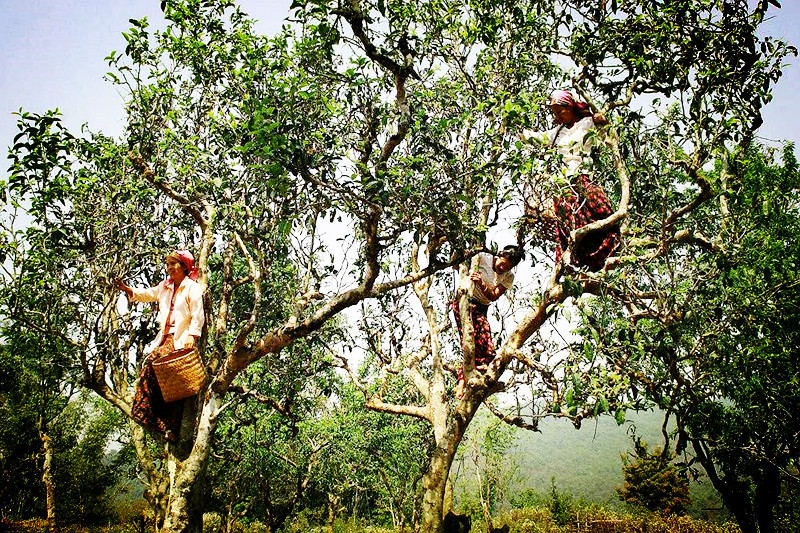
★Distribution of ancient tea mountain in Pu’er City
1. Ancient tea mountain of xuligong tea(须立贡茶)
Located in Lianzhu Town(联珠镇), Mojiang County(墨江县)and Lianzhu town(联珠镇) is a famous post on the ancient tea horse road. The altitude is 1400-1460m and the annual average temperature is 16.9-18 ℃. The annual precipitation is 1323-1435mm. Soil is dark red soil and red soil. The tea of xuligong tea is the royal tribute tea in Qing Dynasty.
Main producing areas: vegetable garden(菜园), Banzhong(班中), Bisheng(碧胜), Yongxi(勇溪).
2.Ancient tea mountain of Longba(龙坝)
It is located in Longba Township(龙坝乡), Tongguan(通关), Mojiang County(墨江县), with an altitude of 1300-1700m and an average annual temperature of 15.0-17.9 ℃. The annual precipitation is 1350mm. The soil is red soil and yellow red soil.
Main producing areas: Longbin(竜宾), Mengli(勐里), damiduo(大乜多), Longchang(竜场), Dadong(打洞), Shitou(石头), mampo(曼婆).
3. Ancient tea mountain of Tongguan(通关)
Located in Yongping Town(永平镇), Mojiang County(墨江县), with an altitude of 1520-1820 meters, annual average temperature of 14.9-16.8 ℃ and annual precipitation of 1391mm. The soil is red soil and yellow brown soil.
Main producing areas: Yongping(永平), Xinwu(新武), Jingba(景坝), biku(毕库).
4. Ancient tea mountain of Baliu(坝溜)
It is mainly distributed in Baliu Township(坝溜乡), Mojiang County(墨江县). The altitude is 1630-1885m, the annual average temperature is 11.9-16.4 ℃ and the annual precipitation is 2197mm. The soil is red soil.
Main producing areas: Lao Zhu(老朱), Lian Zhu(联珠), Lao Peng(老彭), Mani(骂尼).
5. Ancient tea mountain of Midi tribute tea(迷帝贡茶)
It is mainly distributed in Xinfu Township(新抚乡), Mojiang County(墨江县). The altitude is 1300-1940m, the annual average temperature is 14.2-18.3 ℃, the annual precipitation is 1293mm and the soil is red soil and yellow brown soil. The Midi tribute tea has obvious bitterness and astringency, fast into sweet, clear fragrance, little orchid fragrance and obvious wild tastes.
Main producing areas: Jiebei(界碑), Xintang(新塘), banbao(班包), Naxian(那宪).
6. Ancient tea mountain of Jingxinghaomen(景星豪门)
It is mainly distributed in the west of Jingxing Township(景星乡) in Mojiang County(墨江县) and near the Tropic of cancer. The altitude is 1530-1990 m, the annual average temperature is 14.2-16.9 ℃, and the annual precipitation is 1360mm. The soil is red soil, yellow brown soil and purple soil. The tea here is bitter and astringent, slightly sweet with weak fragrance, and obviously into sweet.
Main producing areas: Xinhua(新华), Jingxing(景星), Zhenglong(正龙).
7. Ancient tea mountain of the hill trapped deer(困鹿山)
It is located in Ning’er Town(宁洱镇), Ning’er County(宁洱县), with an altitude of 1090-1640 meters, annual average temperature of 16.5-19.0 ℃ and annual precipitation of 1700mm. The soil is red soil and red soil. The tea in here is obvious natural fresh flavor ,the soup is sweet and smooth. The bitterness and astringency are weak and the sweetness into fast.
Main producing areas: Kuanhong(宽宏), xisa(西萨) and Qiangang(谦岗).
8. Ancient tea mountain of Guoqin(国庆)
It is mainly distributed in Guoqing Township(国庆乡), Jiangcheng County(江城县), with an altitude is 1100-1350m, annual average temperature is 19.2 ℃ and annual precipitation is 2360mm. It’s humid, hot and rainy. The soil is red soil. The tea here is weak in bitterness and astringency, sweet in the soup, good in sweetness, the soup quality not mellow as the Yiwu ancient tea tree.
Main producing areas: Luojie(络捷), Medeng(么等), Tianfang(田房), Gale(嘎勒), Bobie(博别), Heping(和平).
Although the northern part of Pu’er City(普洱市) is not the most famous tea producing area in tradition, with the discovery of the tea tree king of qianjiazhai(千家寨) in Ailao Mountain(哀牢山), people began to pay more and more attention to this area. With the increasing understanding of the wild and cultivated ancient tea tree communities, people’s interest in this area is also growing.
Although many research topics of Pu’er tea are far from the conclusion, there are still many reasons to lock in the Wuliang Mountains(无量山脉), the west slope of Ailao Mountain(哀牢山) and the middle reaches of Lancang River(澜沧江), the river system of Zhegan River(者干江) and Weiyuan River(威远江) as the most abundant and potential areas of Pu’er tea resources.
1. Ancient tea mountain of Laocangfude(老仓福德)
It is located in Anding Township(安定乡) and Wenlong Township(文龙乡) in the north of Jingdong County(景东县)and east slope of Wuliang mountain(无量山), the altitude is 1600-2100 meters, annual average temperature is 11.6-14.6 ℃, precipitation is 1280-1390 mm. The soil is red soil and yellow brown soil, mixed with unweathered gravel. Although the age of the tea here is not very high, it is full of tea fragrance, full of soup quality, long-lasting sweet tastes, with the mountain charm characteristics of the tea in the north of Wuliang Mountain(无量山).
Main producing areas: Yicang(迤仓)、Zhongcang(中仓)、Waicang(外仓)、Hedi(河底)、Minfu(民福)、Bangwei(邦葳)、Bangmai(邦迈)、Yichang(义昌).
2. Ancient tea mountain of Jinding(金鼎)
It is located in the west of slope of Wuliang mountain(无量山) in Linjie Township(林街乡) and Jingfu Township(景福乡), Jingdong County(景东县), with an altitude of 1800-2000 meters. The annual average temperature is 10.6-14.6 ℃ and the precipitation is 1292-1413 mm. The soil is red soil and yellow brown soil, with heavy sand. The tea here is slight bitter,and astringent and bitter can into sweet. The soup tastes full and wild.
Main producing areas: Yantou(岩头)、Longdong(龙洞)、Jingtou(菁头)、Dingpa(丁帕)、Qinghe(清河)、Gold chicken forest(金鸡林)、Gongping(公平)、Chahe(岔河)、Mengling(勐令).
3. Ancient tea mountain of Manwan(漫湾)
Located in Manwan Town(曼湾镇), Jingdong County(景东县), Wuliang Shan west slope(无量山西坡). The altitude is 1700-2300m, the annual average temperature is 13.6-14.6 ℃ and the precipitation is 1291-1307mm. The soil is red soil and yellow brown soil, mixed with unweathered gravel. The tea here is bitter and astringent,the bitterness can turn sweet and the wild taste is obvious.
Main producing areas: Manwan(曼湾)、Anzhao(安召)、Wenzhu(温竹)etc.
4. Ancient tea mountain of Yubi(御笔)
It is located in east slope of Wuliang mountain(无量山) in Wenjing town(文景镇) and Jinping Town(锦屏镇) of Jingdong County(景东县).The altitude is 1700-2000 meters, the annual average temperature is 13.6 ℃ and the precipitation is 1300 mm. The soil is red soil with heavy sand. The tea in here is bitter and astringent, It fast to into sweet and sweet tastes obviously.
Main producing areas: Shanxin(山心)、Bingbi(丙必)、Qingliang Village (清凉村)、Shanchong(山冲)、Huangcao hill(黄草岭).
5. Ancient tea mountain of the west slope in Ailao mountain(哀牢山西坡)
It is located in Longjie Township(龙街乡), Dajie Township(大街乡), Huashan Township(花山乡), and the middle and upper of west slope in Ailao mountain(哀牢山).The altitude is 1300-2100m, the annual average temperature is 12.6-17.6 ℃, and the annual precipitation is 1180-1320mm. The soil includes dark red soil, red soil and yellow brown soil. The tea here is bitter and astringent, bitter tastes can into sweet and tea soup is fragrance.
Main producing areas: East mountain(东山)、Heshao(和哨)、Dajie(大街)、Qili(气力)、Sanying(三营)、Wengang(文岗)、Yingpan(营盘)、Pieluo(撇罗)、Wencha(文岔)、Mountain Lu(芦山).
6. Ancient tea mountain of Zhentai(振太)
Located in Zhentai Township(振太乡), Zhenyuan County(镇沅县), west slope of Wuliangshan(无量山), with an altitude of 1377-1857 meters, annual average temperature of 16.0-18.4 ℃ and annual precipitation of 865-1270 mm. The soil is red soil, red soil and purple soil.
Main producing areas: Shanjie(山街)、Taitou(抬头)、Jiebei(界碑)、Tangfang(塘房)、Shahe(沙河)、Wenpa(文怕)、Changan(长安)、Xiaozhai(小寨)、Huangli(黄梨).
7. Ancient tea mountain of Laowu mountai(老乌山)
It is located in Anban Town(按板镇), Zhenyuan County(镇沅县), with an altitude of 2057-2240 meters, annual average temperature of 14.1-15.2 ℃ and annual precipitation of 1390-1502 mm. The soil is red soil and yellow brown soil. The tea in here the soup is full in quality, rich in tea flavor and deep in fragrance. It is not only a high-quality and high-altitude ancient Pu’er tea variety, but also an important production area of cultivation and transitional high aged ancient trees by Mingshoutang(茗寿堂).
Main producing areas: Wenli(文立)、Luojia(罗家)、Nabu(那布) etc.
8. Ancient tea mountain of Tianba(田坝)
It is located in Tianba Township(田坝乡) and Anban Town(按板镇), Zhenyuan County(镇沅县). The altitude is 1770-1816 meters, the annual average temperature is 16.5 ℃ and the annual precipitation is 1180-1215 mm. The soil is red soil and purple soil. The tea soup here is full in quality, Long-lasting fragrant , bitter and astringent.
Main producing areas: Laohaitang(老海塘)、Chashanjing(茶山菁)、Minqiang(民强)、Waqiao(瓦桥)、Lianmeng(联盟).
9. Ancient tea mountain of Mengda(勐大)
It is located in Mengda Town(勐大镇), Zhenyuan County(镇沅县), with an altitude of 1428-1910 meters, annual average temperature of 15.8-18.1 ℃ and annual precipitation of 920-1910 mm. The soil is dark red soil and red soil.
Main producing areas: Dajing(大井)、Wenkuang(文况)、Wenmeng(文蒙)、Wenkai(文开)、Wenbu(文卜).
10. Ancient tea mountain of Madeng(马邓)
It is located in Zhedong Township(者东乡), Zhenyuan County(镇沅县), with an altitude of 1760-1810 meters. The annual average temperature is 16.2 ℃ and the annual precipitation is 1118-1205mm. The soil is dark red soil and red soil. The tea in here is less bitter and astringent, with a quick return of sweet and sweet soup. Damaidi(大麦地) tea and Madeng(马邓) tea are similar but slightly bitter.
Main producing areas: Maidi(麦地)、Madeng(马邓).
11. Ancient tea mountain of Wenshan(文山)
It is distributed in Jinggu Township(景谷乡), Jinggu County(景谷县), with an altitude of 1610-2010 meters. The annual average temperature is 20.3 ℃, and the annual precipitation is 1296 mm. The soil is red soil and yellow brown soil. The tea here is full in quality, fragrant and sweet. It is sweet in the soup and cool in the sweet.
Main producing areas: Wenshan(文山)、Kuzhushan(苦竹山)、Jinggu(景谷)、Wenzhao(文召)、Yunpan(云盘)、Wenlian(文联)、Tuanshan(团山)、Wendong(文东).
12. Ancient tea mountain of Yangta(秧塔)
It is located in Minle Town(民乐镇), Jinggu County(景谷县), with an altitude of 1110-1780 meters, annual average temperature of 18.7 ℃ and annual precipitation of 1530 mm. The soil is dark red and red. The tea here is heavy fragrant, obvious sweet.
Main producing areas: Dacun(大村)、Baixiang(白象)、Taozi(桃子)、Minle(民乐).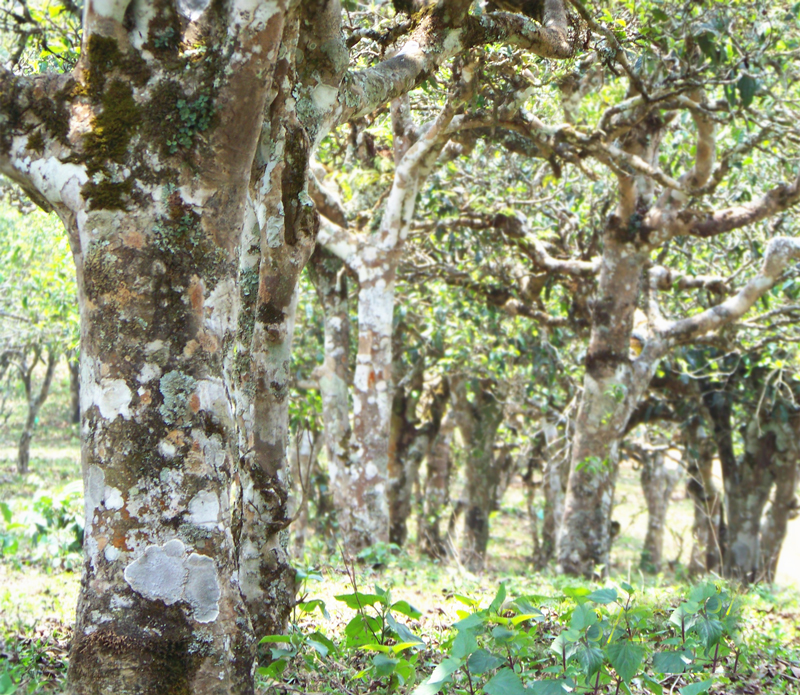
13.Ancient tea mountain of Nanban Yellow grass dam(南板黄草坝)
It is located in Fengshan Township(凤山乡) and Zhengxing town(正兴镇) in the east of Jinggu County(景谷县), with an altitude of 1710-2350m, annual average temperature of 18.7 ℃ and annual precipitation of 1530mm, The soil are red and yellow brown. The tea here has a long-lasting fragrance, weak bitterness and astringency, fast back sweet .
Main producing areas: Yellow grass dam(黄草坝)、Pingtian(平田)、Shunnan(顺南)、Nanban(南板).
14. Ancient tea mountain of Lianhelongtang(联合龙塘)
It is located in Weiyuan Town(威远镇), Jinggu County(景谷县), with an altitude of 1510-1760 meters, annual average temperature of 20.1 ℃ and annual precipitation of 1341.8 mm, Soil are red soil and purple soil.
Main producing areas: Longtang(龙塘)、Lianhe(联合).
15.Ancient tea mountain of Tuanjie(团结)
It is located in Tuanjie village(团结村), Yongping Town(永平镇), Jinggu County(景谷镇), with an altitude of 1090m, annual average temperature of 20 ℃ and annual precipitation of 1410mm. The soil is dark red soil.
★Distribution of Ancient tea trees in Lancang(澜沧), Ximeng(西盟) and mengliangu(孟连)
Traditionally, Lancang(澜沧), Ximeng(西盟) and Menglian(孟连) are called the three counties of the border area. Because they are located in a remote area, the Pu’er tea they produce is not valued. With the discovery of the transitional King of tea in Bangwei(邦葳)in recent years, the ancient tea of Lancang(澜沧) began to emerge. It attracted lot people’s attention because of the unique aroma of Jingmai (景迈)mountain ancient tree tea and it called as “thousands acre thousands year”. Fortunately, there are abundant Jingmai tea(景迈), which is not too much hype.
In fact, the ancient tree resources of the three border counties are not limited to this. With the in-depth study of ancient tea trees, we began to pay attention to the Daheishan(大黑山) system, which is a magical place full of treasures like Ailao Mountain(哀牢山) and Wuliang Mountain(无量山). The ecological environment here is the best preserved in Yunnan, and the wild tea base of mingshoutang(茗寿堂) is also located in Ximeng(西盟). In Menglian(孟连), Ximeng(西盟) and the mountains along the border between China and Myanmar, we often have surprises…
1. Ancient tea mountain of Jingmai(景迈)
It is located in Huimin Township(惠民乡), Jingmai County(景迈县), it is one of the largest existing ancient tea mountains . The altitude is 1100-1570 and an average annual temperature is 16.5-19 ℃. The annual precipitation is 1400-1450mm. The soil is dark red and red. The tea here have the long-lasting fragrant whatever the dry tea and tea soup, the bitter and astringent is obvious, quick into sweet and nice color of tea soup.
Main producing areas: Jingmai(景迈)、Mangjing(芒景)、Manghong(芒洪)、Manggeng(芒埂)、Wengwa(翁洼)、Wengji(翁基)、Laojiufang(老酒房) etc.
2. Ancient tea mountain of Bangwei(邦崴)
It is located in Fudong Township(富东乡), Lancang County(澜沧县), 1640-1780 meters above sea level with annual average temperature of 15.5-16.5 ℃ and annual precipitation of 1100-1300 mm. The soil is red soil. The tea here has obvious bitterness and astringency, fast back sweet, long-lasting fragrance .
Main producing areas: Nadong(那东)、Xiaoba(小坝)、Nandian(南滇).
3. Ancient tea mountain of Wendong(文东)
It is mainly distributed in Wendong Township(文东乡), Lancang County(澜沧县), the altitude is 1740-1970 m, annual average temperature is 14.5-16.0 ℃ and annual precipitation is 1200 mm. The soil is red soil and yellow brown soil. The tea here is bitter and astringent, the orchid fragrance is obvious and still have it after making tea several times. It doesn’t lose with Jingmai(景迈)tea. It’s sweet and fast into sweet.
Main producing areas: Xiaozhai(小寨)、Pasai(帕赛)、Shuitang(水塘)、Yishu(栘树).
4. Ancient tea mountain of Dongka(东卡)
Located in Dapingzhang village(大平掌村), donglang Township(东朗乡), Lancang County(澜沧县), 21 kilometers away from the county . 1550 meters above sea level. The soil is yellow sandy soil. The tea here bitterness is obvious, quick into sweet, long-lasting fragrance and soup is sweet.
5. Ancient tea mountain of Lafu(腊福)
It is located in Lafu village(腊福村), mengma Town(勐马镇), Menglian County(勐连县), with an altitude of 1570 meters. It’s only a few kilometers from the border. The soil is yellow brown soil. The tea here is bitter and astringent taste, long-lasting fragrance, sweet soup and quick back to sweet.
6. Ancient tea mountain of Mangzhong(芒中)
It is located in Jingkeng village(景吭村), Nayun Town(那允镇), Menglian County(孟连县), with an altitude of 1020 meters. The tea here is wild, the bitterness and astringency are weaker and bitterness with sweet .
7. Ancient tea mountain of Fodian mountain (佛殿山)
Located in the west of Ximeng County(西盟县), the annual average temperature is 13.5 ℃,and the annual precipitation is nearly 3000 mm. Altitude about 1700-2200m . The tea here the aroma is steady and long-lasting, bitter and astringent, quick into sweet.
Pu’er(普洱) has diversified ancient tree tea because of its large area and across the Tropic of cancer. The tea mountain in Jiangcheng(江城) and other places in the south is very close to the tea quality in the east of Banna(版纳) tea area. The tea in the West of Lancang(澜沧) and other places has outstanding aroma, long aftertaste and good market competitiveness.
The tea farms in the north of Jingdong(景东) and Zhenyuan(镇沅) are pure and rich tea tastes. With the deepening of people’s understanding of tea , more and more people will pay attention to it. Jinggu(景谷)tea area has a long history with good aroma and taste. There are many ancient tea mountains with large scale, which also represents the direction of the future market. Other places, such as Ximeng(西盟)and Menglian(孟连), although they are small occupy and reputation, their good natural environment depends on the development in the future.
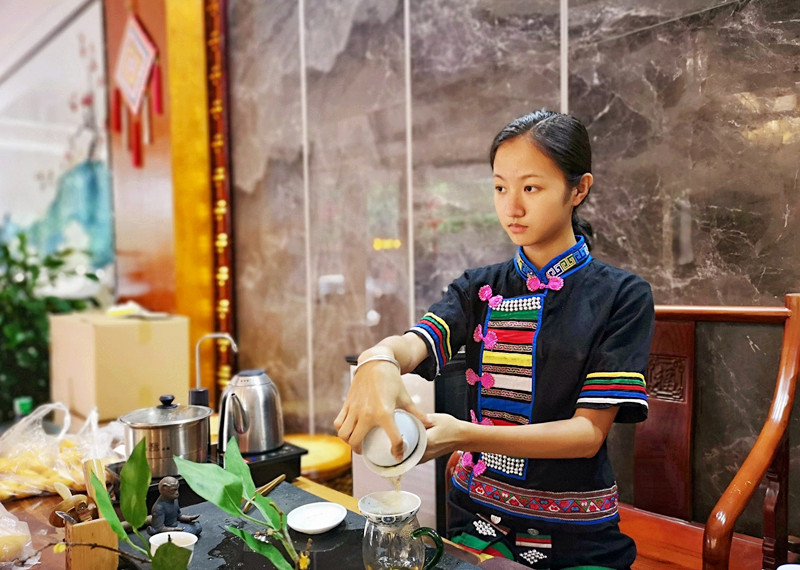
★Distribution of Ancient tea trees in Lincang city(临沧)
Lincang City(临沧市) is named next to lancang river(澜沧江). There are total area of 1.3 million acre of tea garden in the territory, including 400000 acre of wild ancient tea tree community and 650000 acre of cultivated ancient tea garden (over 90000 acre of ancient tea garden over 100 years old). Lincang(临沧) is the most important supplier of Tuo tea(沱茶) raw materials for Xiaguan(下关) tea factory, and also provide a large number of high-quality tea for Kunming(昆明) tea factory and Menghai(勐海) tea factory. Lincang(临沧) tea is the hero behind many famous teas.
Lincang(临沧) has 1 District and 7 counties under its jurisdiction. Each district and county has large area of ancient tea tree resources, ranking according to the tea output, which is Fengqing(凤庆), Yunxian(云县), Yongde(永德), Shuangjiang(双江), Gengma(耿马), Linxiang District(临翔区), Cangyuan(沧源) and zhenkang(镇康) (according to the output in 2009).
1. Fengqing(凤庆)
Located in the north of Lincang. As the largest tea producing county in Yunnan, almost all the counties are suitable for tea planting. It has a long history and produces the famous “Taihua tea” in history. Fengqing(凤庆) tea factory used to be the standard setter of black tea in China. To produce a national level improved species: Fengqing(凤庆) large leaf species. There are 56000 acre of ancient tea resources, Fengshan(凤山), Mengyou(勐佑), Dasi(大寺), Sancha River(三岔河), snow mountain and other places have thousands of acres of ancient tea garden cultivation .
2. Yun county(云县)
Located in the northeast of Lincang(临沧),The wild tea trees are distributed in each town and the famous are: Dazong mountain(大宗山), Xingfu town(幸福镇)、Tanglishu village(堂梨树村) Yongbao town(涌宝镇)、Dabing mountain (大丙山)in Manwan town(漫湾镇)、Huangzhulinqing (黄竹林箐)in Aihua Town(爱华镇) etc. Rich varieties of tea here, which shows the evolution history of different stages from wild tea tree to cultivated tea tree.
3. Yongde(永德)
Located in the northwest of Lincang(临沧),Yongde(永德)with a long history, is known as the place where “ten thousand teas return to their ancestors”. Yongde (永德)is also the county with the largest area of wild tea forest in Yunnan, reaching more than 110000 acre. There are wild tea trees in 11 towns, especially in Minglang(明朗), wumulong(乌木龙), Yalian(亚练), Daxueshan(大雪山) and other places.
4. Shuangjiang(双江)
Located in the south of Lincang(临沧), the tea garden covers an area of 68000 acre. Mengku town(勐库镇) is known as the most important gene pool of Pu’er tea, it is the most famous big leaf tea in Yunnan(云南)of Mengku(勐库) big leaf tea .
5. Gengma(耿马)
Located in the southwest of Lincang(临沧),57000 acre of wild ancient tea trees and especially 30000 acre in Daqingshan(大青山) Nature Reserve.
6. Linxiang district (临翔区)
Located in the Middle East of Lincang(临沧),Ancient tea tree community 20000 acre.
7. Zhenkang(镇康)
Located in the west of Lincang(临沧),The most famous ancient tea tree here is “zhenkang Dashan tea”(镇康大山茶). WanDian(湾甸) tea of Ming Dynasty is most famous .
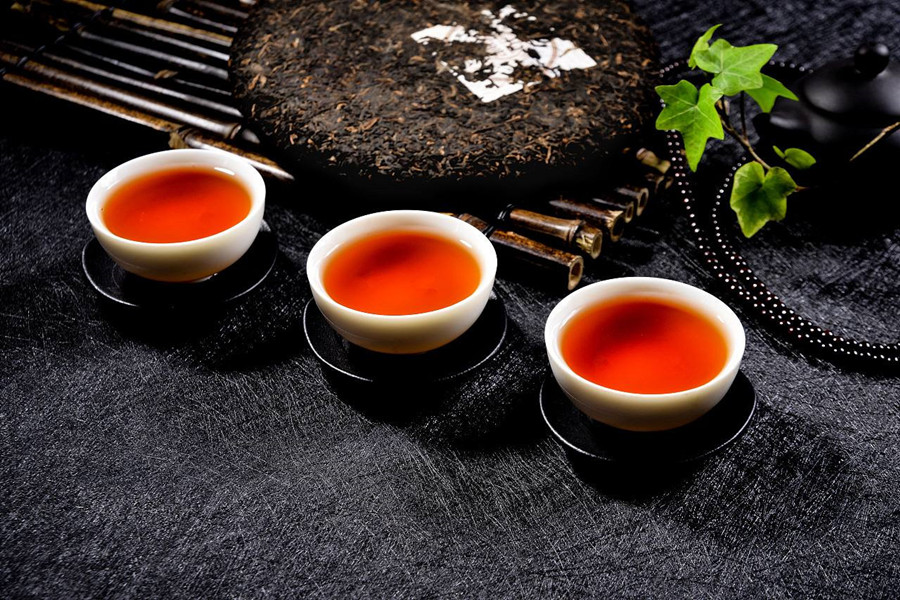
★Distribution of Ancient tea trees in Baoshan(保山)
Baoshan(保山) does not belong to the Lancang River(澜沧江) Basin. In the current Pu’er tea production area of Yunnan Province(云南省), the sun-dry green tea produced by Baoshan(保山) is not popular. However, compared with the over picking situation in Mengla(勐腊), Jinghong(景洪) and Menghai(勐海)of Xishuangbanna(西双版纳),there are still have many cultivated wild tea areas in Baoshan(保山) that still not been fully developed. The tea quality in here still in the high level.
The distribution area of ancient tea trees is nearly 15000 acre. The most concentrated distribution and representative cultivation of the ancient tea garden are Tengchongbawai(腾冲坝外)tea garden、wenjiatang(文家塘) ancient tea garden in Shangying(上营) and huangjiazhai(黄家寨) ancient tea garden in Mangshui Township(漭水乡) in Changning(昌宁). In particular, the ancient trees of Gaoligong Mountain(高黎贡山) system, although it not exceed the characters of the other three tea areas, the strong tea tastes and pure flavor still the most important ancient tea tree resource.
In addition, ancient tea trees are distributed in Dehong(德宏),Wenshan(文山)and other prefectures. Such as Luxi(潞西),Ruili(瑞丽) and Lianghe(梁河) in Dehong(德宏)prefecture; Yuanyang(元阳)and Jinping(金平)in Honghe(红河)prefecture; Guangnan(广南),Maguan(马关)and Malipo(麻栗坡)in Wenshan(文山)prefecture, etc. Although the distribution area of wild tea community and ancient tea garden in there areas is not large, there are many tea plant species in Yunnan(云南).
Chinese Version:
https://www.sohu.com/a/142383525_369603

 7 Days GolfingTour
7 Days GolfingTour
 8 Days Group Tour
8 Days Group Tour
 8 Days Yunnan Tour
8 Days Yunnan Tour
 7 Days Shangri La Hiking
7 Days Shangri La Hiking
 11 Days Yunnan Tour
11 Days Yunnan Tour
 6 Days Yuanyang Terraces
6 Days Yuanyang Terraces
 11 Days Yunnan Tour
11 Days Yunnan Tour
 8 Days South Yunnan
8 Days South Yunnan
 7 Days Tea Tour
7 Days Tea Tour
 8 Days Muslim Tour
8 Days Muslim Tour
 12 Days Self-Driving
12 Days Self-Driving
 4 Days Haba Climbing
4 Days Haba Climbing
 Tiger Leaping Gorge
Tiger Leaping Gorge
 Stone Forest
Stone Forest
 Yunnan-Tibet
Yunnan-Tibet
 Hani Rice Terraces
Hani Rice Terraces
 Kunming
Kunming
 Lijiang
Lijiang
 Shangri-la
Shangri-la
 Dali
Dali
 XishuangBanna
XishuangBanna
 Honghe
Honghe
 Kunming
Kunming
 Lijiang
Lijiang
 Shangri-la
Shangri-la
 Yuanyang Rice Terraces
Yuanyang Rice Terraces
 Nujiang
Nujiang
 XishuangBanna
XishuangBanna
 Spring City Golf
Spring City Golf
 Snow Mountain Golf
Snow Mountain Golf
 Stone Mountain Golf
Stone Mountain Golf












 What Our Customers Say?
What Our Customers Say?
